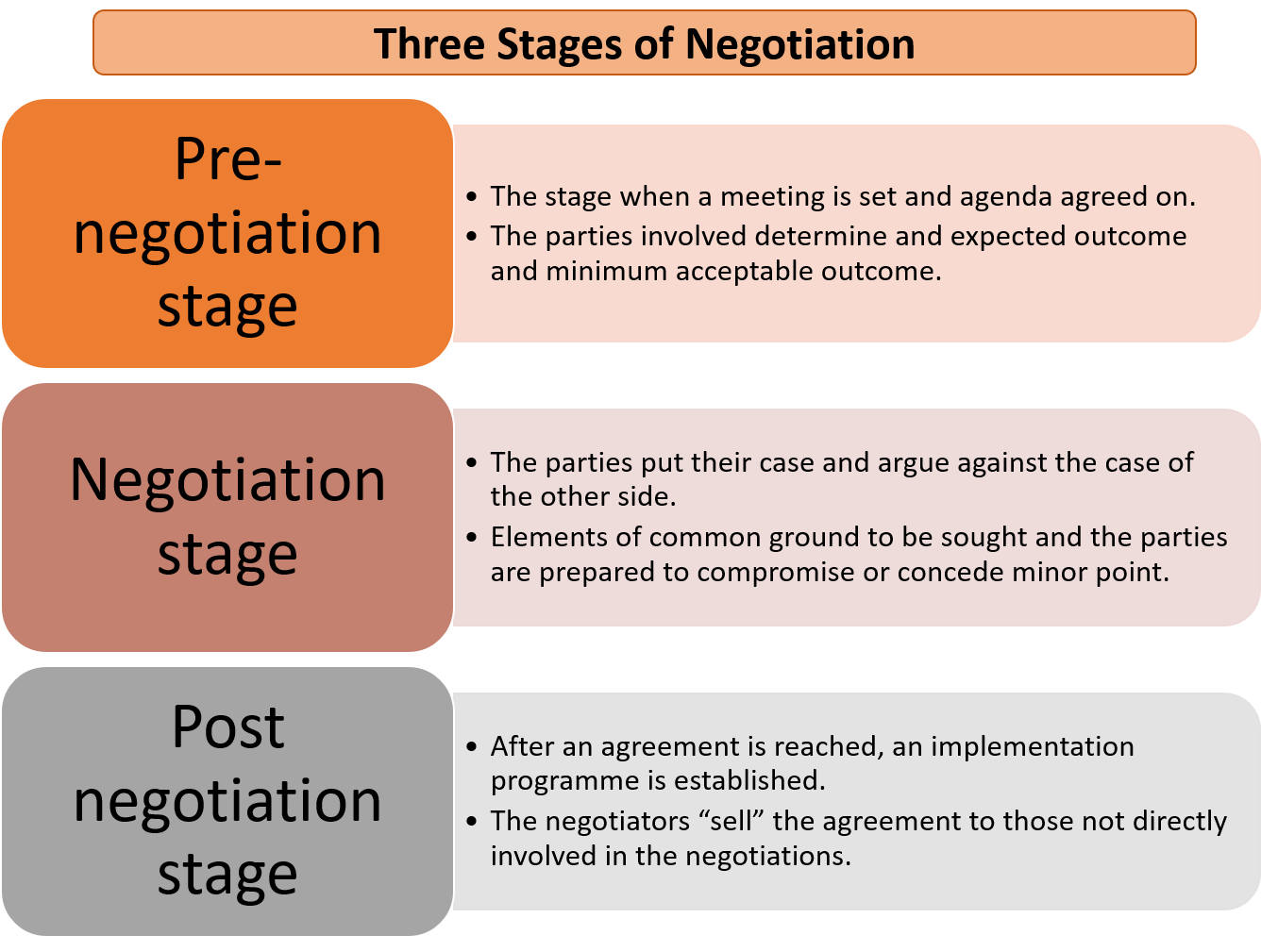
Pre-Negotiation Process
Before actual negotiations between the parties can take place, negotiations about the negotiation process must occur. This phase is sometimes referred to as ‘getting to the table’, and unless the parties are successful in getting there, little can be done to reach a negotiated solution.
This phase is filled with implications for the rest of the negotiation process. An effective pre-negotiation period often covers three ‘tracks’:
- Developing a joint understanding of the problem to be negotiated.
- Reaching agreement on a negotiation process.
- Enhancing the relationship between the parties through trust-building.
If these pre-negotiation tasks are left unaddressed, negotiations may be impeded. By addressing these tasks informally before commencing official negotiations, parties can tackle tough issues in a context that reduces the risk of public scrutiny at a time when parties can still back out of the process if conditions are not favourable. A good pre-negotiation phase can lay the groundwork for trust between the parties because they have an opportunity to work together on building agreements on process without directly addressing substantive proposals.
Developing a Joint Understanding of the Problem

Parties must frame the problem and recognise that they have a common problem that they share an interest in solving. Frames are the conceptions that parties have of the situation and its risks. They allow the parties to begin to develop a shared definition of the issues involved and the process needed to resolve the problem. When the frames of both parties match, they are more likely to focus on common issues and have a common definition of the situation.
However, when the frames do not match, communication between the parties is likely to be more difficult. Unless the different outlooks on the problem begin to overlap, it is unlikely that negotiations will be successful. If negotiators understand what frame they are operating from and what frame the other is operating from, they may be able to shift the conversation and develop common definitions. The way in which parties define the problem can shape the rest of the planning process.
Before official negotiations can occur, both parties must recognize that there is a conflict and that the issues involved are subject to negotiations. In addition, successful negotiations often require that parties have a mutual understanding of the sources of the conflict and the barriers to its resolutions (particularly if you would like to establish a lasting, integrative solution).
The pre-negotiation phase can be a time when the conflict is jointly recognised as a legitimate problem that can be settled through a negotiated solution. This is more easily said than accomplished. Often a range of processes must be utilised before this stage is reached.
Conciliation is important when one or more parties has incurred heavy ‘costs’ because of a protracted conflict and the relationship between the parties is extremely polarised because the most basic channels of communication are weak, and misperceptions are high.
Unofficial consultation processes can be beneficial for opening communication channels, increasing understanding of opposing perceptions of the problem, generating options, and ‘floating’ proposals in a low-risk, private forum.
The parameters of negotiations are often agreed upon prior to officially sitting down at the negotiation table. At some point, direct or indirect communication will need to occur between officials to set the ‘boundaries’ of the negotiation. This involves reaching agreement on what problems or issues are ‘on the table’ and under what terms they will be discussed. Through this process, the broad and diffuse nature of a conflict is made more concrete by narrowing the focus on what will be discussed. Unless the parties share a basic understanding of the nature of the problem, it is often difficult to set boundaries for the negotiation that can provide a framework for a successful negotiation.
Reaching Agreement on a Negotiation Process
Before formal negotiations can begin, basic agreements must be reached on the format and processes that will guide negotiations. This usually includes agreements on participants, negotiating principles and the agenda. Gaining agreement on these criteria tends to decrease the perceived risk of engaging in negotiations, because uncertainty is reduced, and the stakes are clarified. With this knowledge, governmental leaders can often take advanced steps to gain domestic political support and cooperation from international allies.
Participants. Most often, the issue of who participates in bilateral negotiations is straight-forward and non-controversial. It often is a problematic issue in multilateral negotiations and can be the primary stumbling block when one of the parties do not recognise the legitimacy of the other. Sometimes the principle issue of the pre-negotiation phase is that of defining the status of the parties. For example, parties often try to frame status by defining the other party as the aggressor and themselves as the defender. This is important because perceptions of status affect the relative advantages and disadvantages held by each party when entering negotiations. Who participates and at what level can become more complicated with multi-track negotiations, as will be discussed later.
Negotiating Principles. Developing agreement on principles to guide the negotiation can be an important step in clarifying the aims of the negotiation process. Sometimes these principles can set forth a comprehensive framework for addressing a range of issues. Other times, parties agree to tackle only one issue at a time. Discussions about principles are closely linked to defining the boundaries of negotiations and thus clearly address substantive issues. This process is sometimes called ‘setting the terms’ of the negotiations. Parties try to define issues or limit the range of issues to be discussed in a way that will give them an advantage. Often, parties will condition their participation in negotiations by demanding that the other party make a concession prior to engaging in talks.
Agenda. Defining the issues that will be on the negotiation agenda is often one of the most difficult and important tasks in the pre-negotiation phase. What is put on and kept off the table is highly significant and disagreement on the agenda often impedes formal negotiations. Yet if an acceptable agenda is reached, it can lower the risk and the uncertainty parties often feel when entering official negotiations.
Creating an agenda serves the function of organising a complex conflict into a series of definable issues that are then subject to negotiation. How these issues are formulated and how they are clustered impacts on future negotiating processes. Adept formulation can assist in managing complex issues.
The politics of formulating an agenda are often highly-charged. By agreeing to have an issue on the agenda, parties are giving implied acceptance to its legitimacy as a problem. Placing an issue on the table makes the status quo condition subject to change. Yet, unless parties are willing to take this risk, it will be difficult to have the sort of comprehensive discussion that is often necessary to reach a long-term solution.
Reaching agreement on logistics. Parties must agree to the basic setting for the negotiations, a decision that is often loaded with symbolic meaning that can influence the relative comfort or discomfort of the negotiating parties. Once the setting has been agreed upon, someone must coordinate arrangements for a meeting site, oversee the available facilities and support services, plan for contingencies (such as emergency medical care) and arrange for appropriate meals and travel arrangements.

Click here to view a video that explains preparing for a negotiation.